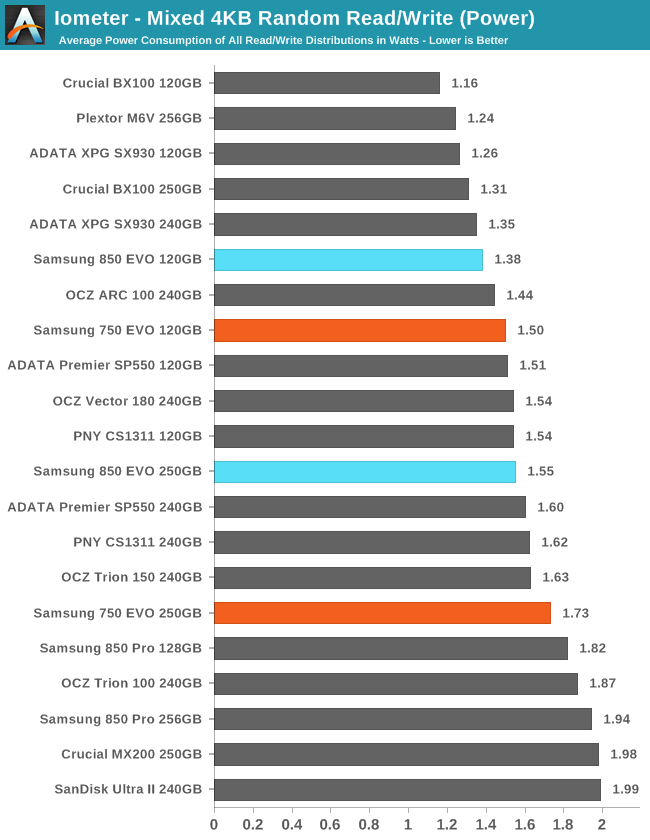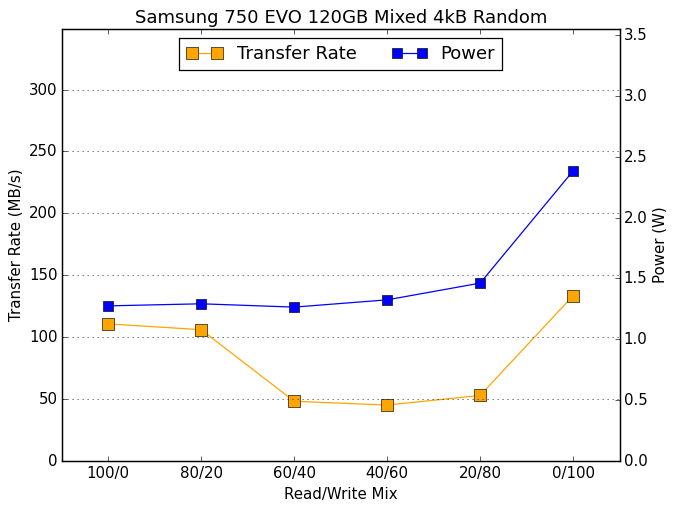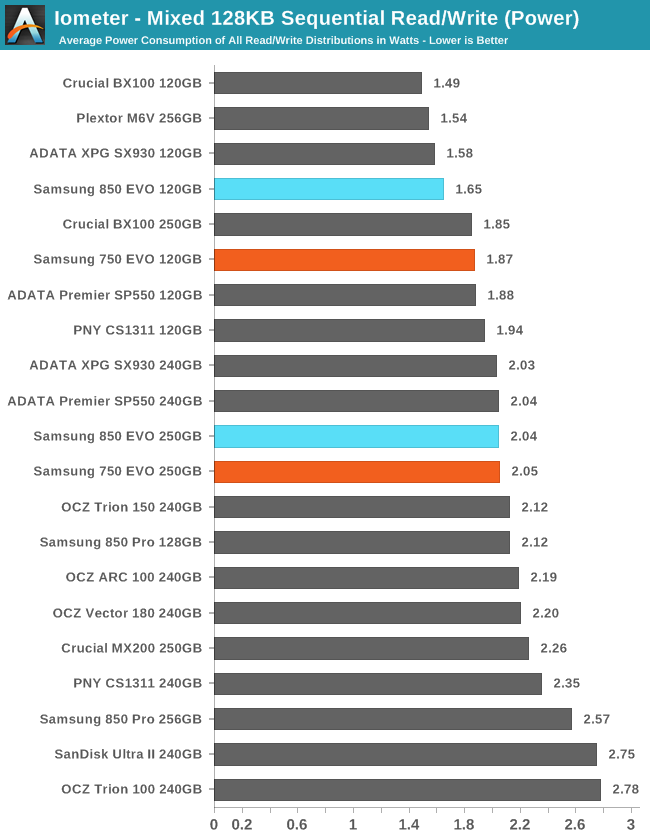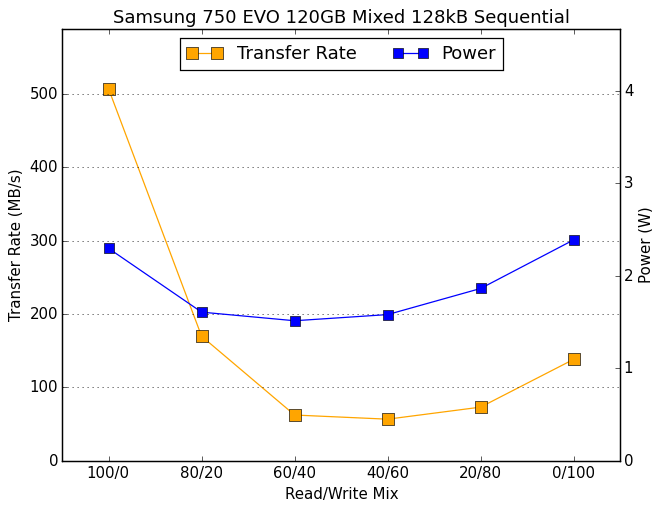The Samsung 750 EVO (120GB & 250GB) SSD Review: A Return To Planar NAND
by Billy Tallis on April 22, 2016 8:00 AM ESTMixed Random Read/Write Performance
The mixed random I/O benchmark starts with a pure read test and gradually increases the proportion of writes, finishing with pure writes. The queue depth is 3 for the entire test and each subtest lasts for 3 minutes, for a total test duration of 18 minutes. As with the pure random write test, this test is restricted to a 16GB span of the drive, which is empty save for the 16GB test file.

The 750 EVO outperforms any non-Samsung drive of similar capacity on the mixed random I/O test, and the 120GB 750 EVO even beats a few MLC drives with twice the capacity.

The 750 EVO has above-average power efficiency during the mixed random I/O test.
 |
|||||||||
Most drives lose performance during the middle phases of the mixed random I/O test. High performance scores on this test rely on performance bouncing back during the final phase of the test when the workload shifts to pure writes. The 750 EVO's spike at the end is noticeable though not huge, but it also benefits from comparatively good performance in the first two sub-tests.
Mixed Sequential Read/Write Performance
The mixed sequential access test covers the entire span of the drive and uses a queue depth of one. It starts with a pure read test and gradually increases the proportion of writes, finishing with pure writes. Each subtest lasts for 3 minutes, for a total test duration of 18 minutes. The drive is filled before the test starts.

Unlike for the mixed random I/O test, most MLC drives are able to maintain a clear performance lead over the planar TLC drives—including the 750 EVO.

The 750 EVO's power consumption is low enough that it is clearly the most efficient planar TLC drive, but its efficiency doesn't beat a typical MLC drive.
 |
|||||||||
The 750 EVO has great read speed, but it bottoms out at a relatively low level during the middle of the test and doesn't bounce back at the end as much as most MLC drives and the 850 EVO.










109 Comments
View All Comments
Coup27 - Friday, April 22, 2016 - link
SATA is not yesterdays tech.abrowne1993 - Friday, April 22, 2016 - link
More like yesteryearDeath666Angel - Friday, April 22, 2016 - link
So, everyone with perfectly capable CPUs that are barely slower than current tech should upgrade because SATA is old? I'm not disputing that SATA is the older tech, I'm just looking for a more nuanced and realistic view here. If your workload is sufficiently dependant on IO throughput, by all means get those NVMe drives. But implying that a SATA3 device like a 850pro is not going to do the job for a lot of people.... I have a Z87 4770k running at 4.5GHz. I'm not going to upgrade just for the convenience of M.2 PCIe NVMe support. And I won't do so until 6+ core CPUs with comparable IPC and OC abilities get decently priced.Meteor2 - Saturday, April 23, 2016 - link
No, not at all, and no-one said SATA is inadequate. But it is part of the past, just like 486s and dial-up modems.Bleakwise - Sunday, April 24, 2016 - link
No, SATA has a place. You realize a 2.5 SATA drive has about 10x-20x the volume of a NVME drive. No reason you could n't have a 3.5 inch SATA SSD either.Thus SATA will always be the go-to for high volume storage. Flash memory isn't going to be shrunk down anytime soon either, it degrades both performance and reliability, so until we get something better than flash SATA is going to be the only place you can get something like a 4TB or 8TB SSD.
Bleakwise - Sunday, April 24, 2016 - link
Shinking thing smaller and smaller is also more expensive, and like I said in terms of flash it also degrades performance. It's much cheaper to build a big-fast thing than a small-fast thing.There is also the issue of RAID and mechanical drives for mass storage. I can setup a 20TB fakeraid with an SSD write-back cache for under a thousand dollars. Hardware raid would be about 2000$. The NVME version would be about 8000$ to 10000$.
Billy Tallis - Sunday, April 24, 2016 - link
There are 2.5" NVMe drives using the U.2 connector to provide the same 4 lanes of PCIe that can be supplied by the M.2 connector.slowdemon21 - Friday, April 29, 2016 - link
Agree. SATA is the skylake bottleneckewitte - Tuesday, May 24, 2016 - link
I hacked my bios to run a 950 pro in a z87 it was ridiculous to spend so much upgrading from a 4790k.Coup27 - Friday, April 22, 2016 - link
Do you not think there is something wrong with the phrase "consumer grade NVMe 2TB+ SSD" ?You could also RAID some SATA 2TB SSD's to give you want you need. I doubt you "really" need all of that space on NVMe, so maybe a 256 or 512GB 950 Pro + some 850 EVO's in RAID would work well, and is available now.